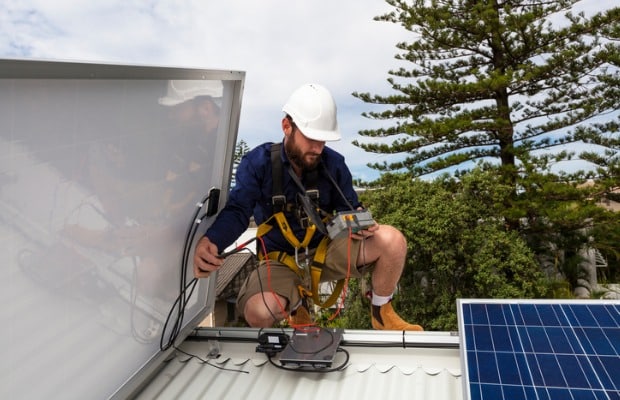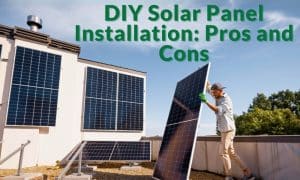Australians are among the world’s leaders in embracing solar energy and have the best solar energy conditions. Solar panels are productive all year round due to the year-round availability of sunlight. Additionally, various solar incentives offered by Australia’s local, state, and federal governments encourage people to switch.
Families using a solar power panel can lower their monthly expenses and carbon footprint. Only some people are comfortable with the idea of living entirely off the grid and relying just on solar energy, but with Net Metering, you can get the best of both worlds.
You can easily get FREE solar quotes from Energy Matters, allowing you to explore the potential benefits of solar energy for your home without any commitment.
What is net metering?
Solar Net Metering is a method that allows typical homes and businesses to use solar power while being plugged into the existing electrical grid. Electrical utility providers use the billing technique to reward customers using solar panel systems known as net metering. Solar panel owners can link their systems to the grid and supply other customers with solar power in exchange for credits.
How does Net Metering work in Australia?
A two-way reading is provided via net metering. It can record how much solar energy you use and feed it into the grid. If you had a net metre to take advantage of solar feed-in tariffs, it could calculate how much you owe for the grid.
Import demonstrates how much power you draw from the grid. You import energy from the grid when your home consumes more energy than your solar panels can generate. Each kWh of electricity you import is subject to the retail electricity rate.
Export indicates the amount of solar energy you provide to the grid. You export when your solar panels produce more energy than your home can need at any time. You get compensated with a feed-in tariff for each kWh of electricity you export.
Here’s a step-by-step look at how this works:
- Solar generation: When the sun is shining, solar panels generate electricity. If this energy meets or exceeds a household’s demand, the excess electricity is automatically sent back to the grid.
- Meter tracking: A bidirectional meter monitors the amount of electricity exported to the grid and the amount drawn from it. This meter is essential for accurately calculating the credit for surplus energy.
- Credit accumulation: The electricity retailer credits the household for the exported energy, reducing the overall energy costs on the monthly bill.
- Billing adjustments: At the end of each billing period, the credits earned through net metering are deducted from the total electricity bill.
Remember:
- The important next step after installing your solar system is setting up your metre.
- Customers who already have smart metres must set them up for net metering.
- Customers using basic metres will require a whole new metre that is solar-ready.
- Upgrading to a net metre is a part of the solar installation process for customers in QLD and VIC who have a new Origin solar system.
- In all other states, customers who own non-Origin solar systems must request net metering from their current electricity provider.
Energy Matters has a nationwide network of trusted local installers ready to provide you with up to 3 Free Solar Quotes. Complete our quick quiz and begin your solar journey today!
What is a feed-in tariff (FiT)?
Every household in Australia receives payment from their electricity retailer for any excess solar energy produced by their system and exported to the grid. A feed in tariff is the amount that appears as a credit on your energy bill. The feed-in tariff’s value varies between states and among electricity retailers.
Surplus electricity is credited at a rate different from the retail price when your electric provider applies a feed-in tariff (FIT) for solar power. Given that the local electric provider continues to bear the cost of transmission and distribution, this FIT is usually lower. In other words,
- Costs for production, transportation, and earnings are all included in your electricity-generated tariff.
- Only the avoided generation costs are used to determine your solar FiT.
Net metering solar benefits: Why net metering matters
Benefits of the Net Metering approach
Net metering provides several advantages for both the homeowner and the environment alike. This lists a couple of benefits of deploying a gridded solar panel system.
Using solar energy significantly reduces your carbon footprint. Increasing your independence can help preserve our planet’s priceless natural resources. Traditional electric or gas-powered generators are far less environmentally friendly than solar power, making you more conscious of needless energy use.
- Reduced energy bills: Net metering offsets energy costs, especially during low or no solar production periods. By lowering their reliance on grid electricity, households can achieve significant savings.
- Faster ROI on solar investments: By capitalising on net metering, solar system owners can expedite their systems’ payback period, making solar more attractive.
- Promotes energy independence: Net metering encourages households to rely more on their self-generated power, fostering energy independence and reducing vulnerability to fluctuating energy prices.
- Supports the grid with renewable energy: Net metering helps distribute solar energy back to the grid, providing a clean energy source and reducing dependence on fossil-fuel-based power.
Maximising benefits from solar net metering
To maximise net metering solar benefits, here are some tips:
1. Choose an energy-efficient system size: Avoid oversizing your solar system; choose a capacity that closely aligns with your household energy needs to reduce wasted energy, such as energy-efficient appliances.
4. Research providers and rates: Energy providers offer varying net metering rates and solar feed-in tariffs. Shopping around for the best rates is essential to maximising your returns.
5. Monitor usage patterns: Adjust your household energy consumption to align with your solar system’s peak production hours to increase your self-consumption rate and reduce reliance on net metering.
6. Consider solar battery storage: While net metering offers immediate benefits, pairing your solar system with a solar battery storage system can maximise savings and reduce dependence on grid power.
Use Energy Matters’ easy-to-use solar power and battery storage calculator to determine the size of your solar system with storage! Our solar calculator will generate performance information and potential savings.
We can send this information to 3 of our pre-vetted and trusted local installers in your area to receive obligation-free solar quotes.
Net metering vs. Solar feed-in tariff: Which is more beneficial?
There are differences between solar net metering and the solar feed-in tariff (FiT), which provides financial benefits for exporting solar power. A solar feed-in tariff is a rate paid to solar owners for each kWh of electricity exported to the grid. Unlike net metering, where users receive credits to offset their consumption, FiT provides a direct payment.

In some states, solar feed-in tariffs have been gradually reduced as solar adoption increased. However, the incentive still offers a significant financial benefit to solar owners, particularly in cases where FiT rates are set at higher-than-retail electricity rates.
Is solar net metering the right choice?
Solar net metering has played an integral role in promoting solar adoption in Australia, providing financial incentives for individuals and businesses to contribute to the renewable energy movement. While policies and feed-in tariffs may vary, the underlying benefits of net metering remain significant. It offers a practical way to reduce energy bills and support Australia’s green energy goals.
Net metering in Australia provides environmental and economic benefits, making it a valuable component of its transition to renewable energy. As the solar landscape continues to evolve, homeowners can expect even more innovative policies, ensuring that the journey toward a sustainable future remains accessible and rewarding.
Ready to make the switch to solar? Contact Energy Matters today to unlock the full potential of solar power and start saving while contributing to Australia’s renewable energy goals. Our team of solar experts can help you get up to 3 FREE solar quotes from pre-qualified and vetted solar firms in your area. Let’s harness the power of the sun together!

















































